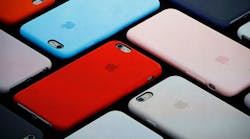As President Donald Trump pushes hard for goods to be “made in America,” how realistic is it to expect Apple to stop manufacturing its iPhones in China?
Trump vowed while campaigning that he would force Apple to bring production to the United States. But as other big companies have sought to appease the new administration with promises of jobs or investments in the United States, Apple has maintained a low profile.
Major Apple contractor Foxconn confirmed earlier this month that it is considering a $7 billion investment to make flat panels in the U.S. in a joint project with Japan’s SoftBank. Founder Terry Gou told reporters in Taipei that he had “discussed with my major clients about going to (the U.S.) and they are also willing to invest, including Apple.”
Foxconn, which is based in Taiwan, has given no details, and Apple declined to comment.
Global Equities Research analyst Trip Chowdhry believed that moving manufacturing to the U.S., where many customers are, was more of a commonsense move than a political one: “You need to manufacture local products in local markets.”
Making things locally gives better control of distribution networks and lets manufacturers customize goods for local markets, the analyst noted.
Whether politically motivated or not, Apple is not in the same position as automakers that relocated U.S. factories overseas to cut costs, according to IHS manufacturing processes chief analyst Dan Panzica. Apple never moved jobs offshore; it created them there.
“The Apple jobs were never here,” Panzica said. “The entire supply chain grew in China.”
Apple benefits in Asia from a network that goes beyond subcontractors assembling smartphones, tablets or laptops. The California-based firm relies on a dense ecosystem of companies that make components and spare parts for its devices as well. China also offers sources of important raw materials, along with cheap, flexible and abundant labor to keep iPhone assembly lines cranking along.
It would be “very hard to replicate” that situation with U.S. workers without using “more robotics and less workforce,” undermining the political aim of creating jobs here, according to Endpoint Technologies analyst Roger Kay.
Exacerbating the challenge, “it makes no sense to make phones here if you have to ship all the components from China,” said technology analyst Jack Gold of J. Gold Associates.
In June, the MIT Technology Review considered several scenarios, from simply bringing assembly to the US to simultaneously shifting the manufacture of parts here. The Review estimated the extra manufacturing cost of an iPhone 6S Plus at $30 to $100 as a result of those moves. It is difficult to imagine that Apple would risk its status as the world’s most profitable company to absorb such a hike in manufacturing costs.
“Apple will never lower its margins on its flagship product,” Ovum consumer technologies analyst Ronan de Renesse said.
Apple is under pressure from investors to keep its high margins, and already faces slowing growth of iPhone sales.
So, would U.S. consumers put their money where the political talk is and pay more for iPhones stamped “Made in the USA”? Not all analysts were convinced.
It was seen as more likely that Apple would make a symbolic move to appease Washington, such as investing more in making Mac Pro computers here, or in a facility for higher-priced, limited-edition devices such as an “anniversary edition iPhone” to mark the handset’s 10th anniversary this year.
“I would be very surprised to see a major production shift to the U.S.,” Gold said while discussing Apple.
Breaking the U.S. technology star’s successful business model should be out of the question for the Trump administration, and there is likely to be a compromise such as “financial incentives,” according to de Renesse.
Foxconn is already trying to get U.S. states to woo it with grants of land, cheap energy, or tax breaks. Apple could seek tax amnesty for the $200 billion or so in profits it keeps overseas in exchange for increasing local manufacturing.
The economic equation would change if Trump went on the offensive by imposing heavy customs duties on Chinese imports. Given Apple’s dependencies on partners in China, and its keen desire to gain traction in that market, Apple could find itself an early casualty in a U.S. trade battle with Beijing.
By Sophie Estienne



